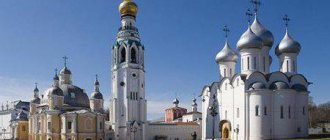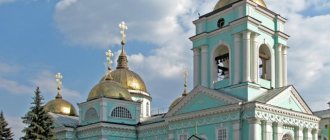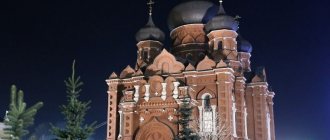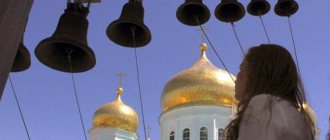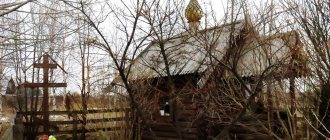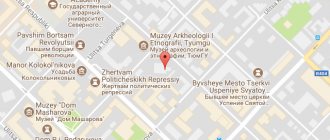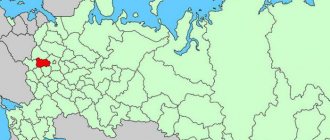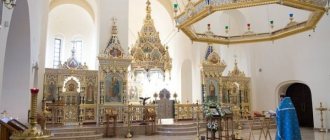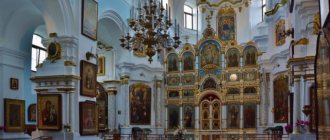The Resurrection Cathedral is a former warm cathedral in Vologda (under the cold St. Sophia Cathedral), built in 1772-1776 at the behest of Vologda Archbishop Joseph Zolotoy in the Baroque style. Currently, it is the main building of the Vologda Regional Art Gallery, an architectural monument of federal significance.
In June 2015, Governor Oleg Kuvshinnikov, following a meeting with the head of the Federal Property Management Agency Olga Dergunova, announced that the cathedral would be transferred to the Vologda diocese by July 1, 2021.
Story
The decision to build a warm (winter) cathedral was made in the early 1750s under Bishop Serapion. The first attempt to build a cathedral was made in 1757 already under Joseph the Golden, and was consecrated in the name of the Presentation of the Lord. However, the building, completed in 1771, was dismantled because “many were found on it on arches, in crevices,” and the cathedral was recognized as “very unreliable for completion.”
The new Resurrection Cathedral was built on the site of the dismantled south-eastern tower of the Vologda Kremlin. Stone from the ruins of its fortress walls and towers was used for construction. It is believed that the construction was carried out by local architect Zlatitsky according to a model made by a capital master. The wooden model, characterized by a higher dome and fine detailing, is kept in the Vologda State Museum-Reserve. Construction was completed in 1776, after the death of Joseph the Golden, under Bishop Irenaeus.
Church of Elijah the Prophet in Kamenye
Church of Elijah the Prophet in Kamenye - Orthodox church, inactive, address: st. Zasodimsky, 14B.
The Church of Elijah the Prophet is a small white cubic stone temple, made in a very attractive and harmonious design due to its simplicity. The decoration of the church is only a relief cornice and one dome of a classical form.
The church was built in 1698 and has survived to this day. But the date of construction of the previous wooden church is unknown, because the chronicle of the Elias Monastery (which included the Church of Elijah the Prophet) began only with the arrival of Ivan the Terrible (mid-16th century). In 1738, the Ilyinsky Monastery was abolished, and the church became a parish.
The postscript “in Kamenye” probably appeared due to the storage in these places of reserves of stones for the construction of the Vologda Kremlin. There is also an assumption that previously there was a stone pagan idol at this place.
Architecture
The Resurrection Cathedral is a two-story building, oval in plan, with five domes. It has a refectory, four semicircular chapels on the sides and an elongated altar. The cathedral is crowned with a large dome with oval windows and lucarnes, topped with a lantern with a dome. The dome is surrounded by two-tiered octagonal turrets - the heads of the aisles.
The facades are decorated with Tuscan columns and pilasters, the windows are framed by figured platbands. The main entrance to the cathedral from Kremlin Square was built in the Empire style (with a pediment and columns also of the Tuscan order) for the arrival of Emperor Alexander I.
According to art historians, the original project was simplified and roughened during construction. G.K. Lukomsky describes the architecture of the cathedral as follows:
...A rather chaotic and shapeless structure. Conceived, apparently, in interesting forms of the Baroque era (judging by the wooden model stored in the cathedral ancient depository), in implementation it, unfortunately, underwent changes, and the proportions of the dome, which became flattened, and the details were especially damaged: the columns turned out to be cut off, rough, not carefully sculpted platbands and cornices.
Thus, the Baroque style received a not quite typical expression in this temple, painted in dark yellow and white tones. The reception was good - getting the temple itself round seemed very tempting, but, unfortunately, in a remote province it was difficult to complete the details that required delicate elaboration.
Shrines of the cathedral
The main relics available in the parish:
- Icon of the Holy Blessed Princess Anna Kashinskaya with a particle of relics
- Reliquary with the relics of Saint Prince Andrew
- Temple icon of the Nativity of the Virgin Mary in the altar
- Icon "Joy of All Who Sorrow"
- List of the icon of the Mother of God “Quick to Hear”
- Relics of St. Joasaph of Kamensky
- List of the “Ordinary” icon of the Savior from the Vsegradsky Cathedral
The temple has its own iconostasis, which is a wooden structure. The iconostasis is equipped with special niches for icons. The cathedral has a painting of the Last Supper located above the royal gate. The iconostasis is decorated with carved royal gates with inserts of holy icons: “Annunciation”, “Nativity of the Mother of God”, “Savior Pantocrator”, “Our Lady and Child Sovereign”, “Trinity”, “Entrance into Jerusalem”, “Apostle Paul”, “Archangel Uriel” , “Nicholas the Wonderworker”, “Transfiguration”, “John the Theologian”, “Nativity of Christ”, “Introduction of Mary into the Temple”, “Ascension”.
In the cathedral, the following icons are especially revered by parishioners: “Galaktion of Vologda”, “Our Lady of the Seven Arrows”, “The All-Merciful Savior”, “Our Lady of Kazan”, “Our Lady of Sorrows”.
Interior
It is difficult to judge the original interior decoration of the cathedral. In 1832-1833, the interior of the cathedral underwent renovation. According to G.K. Lukomsky,
Inside the cathedral there is absolutely nothing interesting. The painting (ornamental) exposes the bad taste of the era of Alexander II and III, and icon cases, iconostases and all objects bear the imprint of bad taste, typical of the era of quasi-Russian style, reeking of cold craftsmanship and attempts at luxury.
From 1847 to 1928, in the refectory of the cathedral there was an icon of the Trinity “Zyryanskaya” of the 14th century, unique for its inscriptions in the Komi-Zyryan language, made in ancient Perm script.
Church of Varlaam Khutynsky
Church of Varlaam Khutynsky - Orthodox church, inactive, address: st. Zasodimsky, 14A.
The Church of Varlaam Khutynsky, like the Church of Elijah the Prophet, was a parish of the now abolished Elias Monastery. The building, which has survived to this day, was built in 1780 - after the closure of the monastery. The architect of the church remained unknown, but it is believed that it was a master from St. Petersburg.
In its appearance, the church reflects the influence of early classicism. The main entrance is decorated with a semi-rotunda with four columns. The slender, graceful through bell tower is also richly decorated with columns. The church has 4 chapters, but all of them are played out so skillfully that at first glance you cannot see them. One dome is made in the form of a sharp spire on a bell tower, the second crowns the drum on the opposite side of the temple, and two more domes are disguised as decorative flowerpots on either side of the drum.
Temples of Vologda
The temples of Vologda are numerous and interesting. Among them there are no particularly ancient pre-Mongol monuments. However, in Vologda there is a lot of interesting things for connoisseurs of Russian temple architecture. We will get acquainted with most of the monuments of church architecture in Vologda. Photos in the article are copyrighted, 2009 and 2021.
Table of contents
Temples of Vologda. Cathedral Hill
The Cathedral Hill is located within the fortress from the times of Ivan the Terrible. It is here that the oldest temple in Vologda stands - St. Sophia Cathedral. It serves as the dominant feature of the ensemble of the bishop's court or the Vologda Kremlin. St. Sophia Cathedral remains the most important building in the city to this day.
View of Cathedral Hill from Zarechye
St. Sophia Cathedral was built in 1568-70 by order of Ivan the Terrible. The model was the Assumption Cathedral of the Moscow Kremlin. A folk song was composed about the construction of the cathedral and the sudden departure of the sovereign from Vologda.
That on the glorious river Vologda In Nason there was a city, Where hitherto, the Terrible Tsar wanted to found a throne city, For his own majesty And for the royal power; He fortified the stone city with a wall, With high towers, With impregnable loopholes. In the middle of the city he built a church, a molded, cathedral church, in the name of the Mother of God, Her venerable Dormition; He took a sample from the Moscow Cathedral, from the Assumption Cathedral. The walls of the temple rose - Christians were consoled. After they began to build the vault, the king himself was unable to walk; He supervised the mercenaries, so that they could build God’s temple more firmly, and would not spare the red plinths and that flammable lime.
When the king was upset about this, he walked around in the new temple, as if from a dull vault a red plinth fell, hit him in the head, in the wild little head, in the mudra of the king’s head. How our Terrible Tsar became angry, The blood in all veins became agitated, The brave chest began to boil, The zealous heart became enraged; He left the new temple, He mounted a good horse, He left for stone Moscow, Nason-city, cursing
Saint Sophia Cathedral
The council was completed after the sudden departure of the sovereign. This is a five-domed, six-pillar temple with a mosquito roof. Its smooth walls are cut through by slit-like windows. The plane of the wall is broken by blades on which the mosquito bars rest. From the east, semicircular altar apses adjoin the main volume of the temple.
More than a hundred years later, at the end of the 17th century, the Yaroslavl artel, led by the “isographer” Dmitry Plekhanov, painted the cathedral with frescoes.
Interior of St. Sophia Cathedral. Photo from 2009
The iconostasis of the cathedral is the third in a row. It was made in the first half of the 18th century.
St. Sophia Cathedral unites the ensembles of Cathedral Square and the Bishop's Courtyard.
Cathedral bell tower
The Cathedral Bell Tower serves as the dominant feature not only of Cathedral Hill but of the entire historical Vologda. At the heart of the current bell tower is a hipped belfry from the mid-17th century. Two hundred years later, Bishop Palladius decided that the cathedral belfry should be the tallest in the diocese. By his order, the provincial architect Vladimir Schildknecht built the bell tower to a height of 75 meters. She is only 5 meters lower than Ivan the Great.
Cathedral bell tower and economical building
Vologda bells number 25 bells. The oldest ones date back to the 17th century. Each of them has its own name: “Festive”, “Sentry”, “Water Carrier”, “Big Swan”, “Little Swan” and “Arkhangelsky”.
Bell “Big Swan”. Gift of Peter I
Temples of Vologda. Kremlin
In the 19th century, the name “Kremlin” was assigned to the bishop’s court. The ensemble includes three more churches. The oldest of them dates back to the 60s of the 17th century. This is the house church of the Nativity of Christ, included in the Simonovsky building along with the earlier Cross Chamber. Three grand meals were held in the Cross Chamber in honor of the visits of Peter I to Vologda.
On the northern side of the Kremlin, the Holy Gates of 1671-75 have been preserved. The gates were erected over two arches - wider for carriages and narrower for pedestrians.
